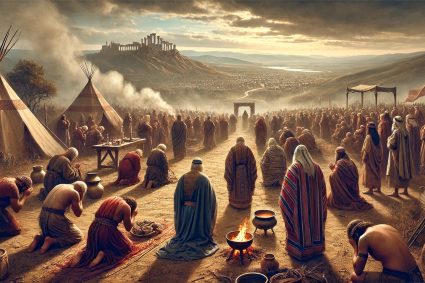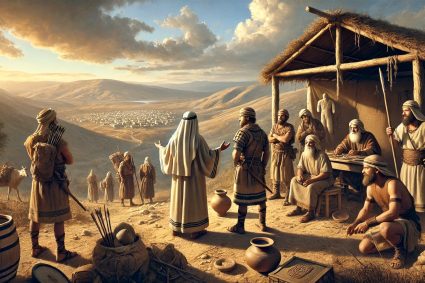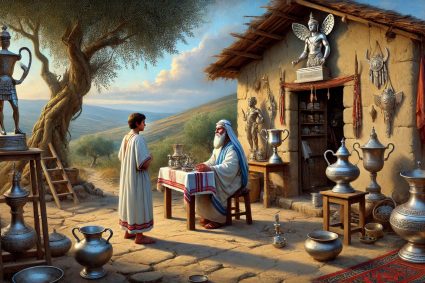
July 3, 2024
DAILY BIBLE READING – Nahum Chapter 2
1 He that dasheth in pieces is come up before thy face: keep the munition, watch the way, make thy loins strong, fortify thy power mightily.
2 For the Lord hath turned away the excellency of Jacob, as the excellency of Israel: for the emptiers have emptied them out, and marred their vine branches.
3 The shield of his mighty men is made red, the valiant men are in scarlet: the chariots shall be with flaming torches in the day of his preparation, and the fir trees shall be terribly shaken.
4 The chariots shall rage in the streets, they shall justle one against another in the broad ways: they shall seem like torches, they shall run like the lightnings.
5 He shall recount his worthies: they shall stumble in their walk; they shall make haste to the wall thereof, and the defence shall be prepared.
6 The gates of the rivers shall be opened, and the palace shall be dissolved.
7 And Huzzab shall be led away captive, she shall be brought up, and her maids shall lead her as with the voice of doves, tabering upon their breasts.
8 But Nineveh is of old like a pool of water: yet they shall flee away. Stand, stand, shall they cry; but none shall look back.
9 Take ye the spoil of silver, take the spoil of gold: for there is none end of the store and glory out of all the pleasant furniture.
10 She is empty, and void, and waste: and the heart melteth, and the knees smite together, and much pain is in all loins, and the faces of them all gather blackness.
11 Where is the dwelling of the lions, and the feedingplace of the young lions, where the lion, even the old lion, walked, and the lion’s whelp, and none made them afraid?
12 The lion did tear in pieces enough for his whelps, and strangled for his lionesses, and filled his holes with prey, and his dens with ravin.
13 Behold, I am against thee, saith the Lord of hosts, and I will burn her chariots in the smoke, and the sword shall devour thy young lions: and I will cut off thy prey from the earth, and the voice of thy messengers shall no more be heard.
King James Version. Public Domain
Commentary
Verses 1-2:
The announcement of Nineveh’s destruction begins with a hopeful message to Judah. The prophet Nahum envisions the feet of a good messenger on the mountains, proclaiming peace. This is a call for Judah to observe its festivals and fulfill its vows, as the threat from the Assyrians will soon end. However, the “scatterer” is coming, and Judah is instructed to prepare for the siege and maximize its strength.
Verses 3-4:
Nahum prophesies that the Lord will restore the splendor of Jacob and Israel. The enemies have plundered and devastated the land, but the coming destruction of Nineveh will reverse this disgrace. The description of the red shields and purple uniforms of the attackers, as well as the gleaming chariots, conveys an image of power and threat.
Verses 5-6:
The metaphors of the rolling and flashing chariots illustrate the intensity and chaos of the impending battle. Despite the Assyrians’ efforts to fortify their defenses and mobilize their mightiest warriors, they will fail.
Verses 7-8:
The gates will be opened, and the palace will collapse. The captured queen and her mourning maidens symbolize Nineveh’s total defeat and humiliation. The image of the sighing maidens beating their breasts amplifies the city’s tragedy.
Verses 9-10:
Nineveh, once a wealthy and powerful place, will now be plundered. The calls to stand firm are ignored, and the city is abandoned and looted. The treasures and precious items that once were Nineveh’s pride are stolen, and the inhabitants are gripped by fear and despair.
Verses 11-12:
Nahum uses the image of the lion to describe Nineveh’s former power and security. The lion’s den, a symbol of strength and protection, is now deserted. The question, “Where is the lions’ den now?” underscores the shift from power and security to devastation and fear.
Verses 13-14:
The Lord of Hosts declares that He will act against Nineveh. The destruction of the chariots and the young lions being devoured by the sword symbolize the end of Nineveh’s power. The prophecy concludes with the final declaration of the end of Nineveh’s plundering and the silencing of its messengers’ voices.
Summary:
Nahum Chapter 2 is a powerful prophecy of Nineveh’s destruction, offering both hope for Judah and a warning of impending punishment for Nineveh. The vivid descriptions and metaphors convey the intensity and inevitability of divine judgment. The text illustrates the reversal of power and prosperity and the absolute defeat of a proud and mighty city.
![]()

WEEKLY SPIRIT OF PROPHECY READING – Ellen White | The Desire of Ages Chapter 42: Tradition
This chapter is based on Matthew 15:1-20; Mark 7:1-23.
Read online here.
Commentary
Background and Context:
Chapter 42 addresses the confrontation between Jesus and the Pharisees as well as the scribes who intended to trap him. The Pharisees and scribes were eager to accuse Jesus of disregarding the traditional regulations, particularly concerning ritual cleansings. These regulations, created as protective measures around God’s law, had become so significant over time that they overshadowed the actual commandments of God.
The Accusation of the Pharisees and Scribes:
The Pharisees and scribes confront Jesus and ask him why his disciples transgress the traditions of the elders by not washing their hands before eating (Matthew 15:2). This question indicates that the religious leaders valued human traditions more than God’s actual commandments.
Jesus’ Response and True Purity:
Jesus does not directly defend himself or his disciples but points out the hypocrisy of the Pharisees. He quotes Isaiah to highlight their hearts’ distance from God (Matthew 15:7-9). Jesus emphasizes that what comes from outside into a person does not defile them, but what comes from the heart does. Evil thoughts, words, and deeds are the true source of defilement, not the neglect of external, man-made ordinances.
Criticism of Human Traditions:
Jesus makes it clear that the Pharisees and scribes nullify God’s commandments through their traditions. An example of this is the practice of refusing support to parents by declaring possessions as “Korban” (offering). This practice illustrates how human traditions are misused to circumvent divine commandments (Mark 7:9-12).
Resistance and Hostility:
The Pharisees’ reaction to Jesus’ words is anger, as they see their falsehood and hypocrisy exposed. Jesus points out that human customs and traditions not originating from God are ultimately worthless and will be uprooted (Matthew 15:13).
Relevance and Application:
Even today, people tend to place human traditions and customs above God’s commandments. This tendency often leads to hostility towards those who point out the flaws in such practices. In modern Christian practice, many institutions and traditions have no better foundation than the traditions of the fathers. It is crucial that we rely on God’s word and not be distracted by human regulations.
Summary:
Chapter 42 illuminates the dispute between Jesus and the religious leaders of his time regarding the importance of traditions compared to God’s commandments. Jesus emphasizes the importance of inner purity and adhering to divine commandments over human traditions. This teaching remains relevant, reminding us that true purity and obedience to God come from the heart and are not determined by external rituals or human regulations.

WEEKLY SPIRIT OF PROPHECY READING – Ellen White | The Desire of Ages Chapter 43: Barriers Broken Down
This chapter is based on Matthew 15:21-28; Mark 7:24-30.
Read online here.
Commentary
Background and Context:
After his encounter with the Pharisees, Jesus withdraws from Capernaum and travels to the region of Tyre and Sidon to find seclusion and rest. This journey not only aims for rest but also serves to prepare his disciples for their future mission, which will extend beyond the borders of Israel. Jesus uses this opportunity to teach his disciples important lessons about grace, faith, and the universality of the gospel.
The Encounter with the Canaanite Woman:
Verses 21-22: The Canaanite woman who approaches Jesus presents a remarkable contrast to the religious leaders who have just challenged him. She is a Gentile, despised and excluded by the Jews, yet she shows deep faith and remarkable persistence by asking Jesus to heal her daughter. Her address, “Lord, Son of David,” indicates her recognition of his messianic role.
The Testing of Faith:
Jesus initially ignores the woman’s plea and gives her an apparently dismissive response. This reaction may seem harsh or heartless but serves a deeper purpose. Jesus wants to highlight to his disciples the prevalent prejudices and the harsh attitude of the Jews towards Gentiles. At the same time, he tests the woman’s faith and gives her the opportunity to demonstrate her steadfast faith and humility.
The Woman’s Response:
Despite the dismissive words, the woman remains undeterred. She seizes the opportunity and responds with remarkable humility and faith, saying that even the dogs eat the crumbs that fall from the children’s table. This response shows that she not only claims God’s grace for herself but also understands his mercy and love that transcend all cultural and ethnic boundaries.
Jesus’ Reaction:
Impressed by her faith and humility, Jesus grants her request and heals her daughter. This action clearly demonstrates that God’s grace and healing are accessible to all, regardless of their background or status. It is a powerful example of overcoming prejudices and the inclusiveness of the gospel.
Lessons for the Disciples:
Jesus uses this encounter to teach his disciples several important lessons:
-
Faith and Persistence: The unwavering faith and persistence of the woman serve as a model for the disciples and all believers.
-
Universality of the Gospel: Jesus shows that his mission and the message of the gospel are not limited to the Jewish people but are meant for all humanity.
-
Overcoming Prejudices: The encounter teaches the disciples to recognize and overcome their own prejudices and those of their culture.
Far-reaching Significance:
This event has far-reaching implications for understanding Jesus’ mission and the role of the disciples. It shows that the gospel is meant to break down barriers of race, culture, and religion, and that faith and humility are the key factors in receiving God’s grace.
Relevance and Application:
Even today, social, cultural, and religious barriers exist that separate people. The lessons from this story remind us that God’s love and grace are accessible to all people and that we as believers are called to carry this message of inclusivity and mercy to the world.
Conclusion:
The story of Jesus and the Canaanite woman is a powerful testimony to overcoming prejudices and the universal nature of the gospel. It shows that true faith and humility are the keys to receiving God’s grace and that no human barrier is strong enough to limit God’s love and mercy. This teaching is as relevant today as it was then, challenging us to live out and share the universal message of the gospel.

WEEKLY SPIRIT OF PROPHECY READING – Ellen White | The Desire of Ages Chapter 44: The True Sign
This chapter is based on Matthew 15:29-39; Matthew 16:1-12; Mark 7:31-37; Mark 8:1-21.
Read online here.
Commentary
Background and Context:
In this chapter, we witness the continuation of Jesus’ ministry in non-Jewish areas following his encounter with the Canaanite woman. He traveled through Sidon, came to the Sea of Galilee, and entered the region of the Decapolis. These regions were predominantly inhabited by Gentiles, which makes Jesus’ mission at this time unusual since he had primarily ministered among the Jews.
The Healing of the Deaf-Mute (Mark 7:31-37):
-
Verse 31: Jesus travels from Tyre through Sidon to the Sea of Galilee, into the region of the Decapolis. This movement shows that Jesus is also working in Gentile areas, indicating that his message and healings are not limited to the Jews.
-
Verses 32-35: People bring a deaf-mute man to Jesus and beg him to heal him. Jesus takes the man aside, puts his fingers in the man’s ears, and touches his tongue. These physical actions demonstrate Jesus’ personal and caring approach. He sighs, looks up to heaven, and says, “Ephphatha” (Be opened). Immediately, the man can hear and speak. This healing not only shows Jesus’ power but also his deep compassion and ability to overcome physical and spiritual barriers.
-
Verses 36-37: Jesus instructs the people not to speak about it, but they spread the news anyway. This shows the overwhelming impact of Jesus’ miracles on the people and their inability to remain silent about such marvelous events.
The Feeding of the Four Thousand (Matthew 15:29-39):
-
Verses 29-31: Jesus goes up a mountain, and a large crowd follows him. They bring the sick and lame to him, and he heals them. These miracles cause the crowd—consisting of Gentiles—to praise the God of Israel. This is remarkable as it shows that Jesus’ works are also recognized among the Gentiles and that God is being praised.
-
Verses 32-39: After the crowd has been with Jesus for three days and has no food left, Jesus expresses his compassion and decides to feed them. The disciples again doubt the possibility of feeding so many people in the wilderness. But Jesus repeats the miracle of feeding: with seven loaves and a few fish, he feeds four thousand men, along with women and children. Seven baskets of leftovers remain. This feeding again shows Jesus’ power and compassion and serves as a model for the disciples that God’s provision is unlimited and extends beyond all cultural boundaries.
The Challenge by the Pharisees and Sadducees (Matthew 16:1-4):
-
Verses 1-4: After returning to Jewish areas, the Pharisees and Sadducees demand a sign from heaven as proof of his divine mission. Jesus rejects this demand and says that no sign will be given except the sign of the prophet Jonah. This response shows that outward signs and miracles alone are not enough to overcome unbelief; it requires an inner change of heart.
Lessons and Application:
-
Faith and Compassion: Jesus’ healing of the deaf-mute and the feeding of the four thousand demonstrate his deep compassion and willingness to help all people, regardless of their background. This teaches us that faith and compassion go hand in hand and that we are called to express our faith through acts of love and care.
-
Overcoming Prejudices: The disciples need to learn to overcome their Jewish prejudices against Gentiles. Jesus’ work in Gentile areas shows that God’s love and grace are accessible to all people. This is an important lesson for us to recognize and overcome prejudices and discrimination in our own lives.
-
The True Sign: Jesus’ response to the Pharisees and Sadducees emphasizes that true signs and wonders are not of an outward nature but consist of an inner change of heart and faith in God’s word. This challenges us to examine our own spiritual lives and ensure that we are not merely seeking outward proofs but striving for a deep and authentic relationship with God.
Summary:
Chapter 44 shows how Jesus breaks down the barriers between Jews and Gentiles, revealing the universal nature of his message and ministry. His healings and miracles in Gentile areas, along with his teachings on true faith, challenge us to overcome our own prejudices and limitations and to develop a deeper, more compassionate, and more authentic relationship with God.
Visited 29 times, 1 visit(s) today






